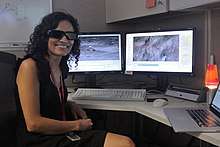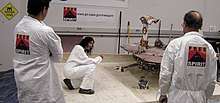Vandi Verma
Vandana "Vandi" Verma [1] is a space roboticist at NASA's Jet Propulsion Laboratory known for driving the Mars rovers, notably Curiosity, using software including PLEXIL programming technology that she co-wrote and developed.[4][5]
Dr. Vandi Verma | |
|---|---|
 | |
| Born | Vandana Verma |
| Other names | Vandi Verma Tompkins[1] |
| Education | Kendriya Vidyalaya No. 2, Halwara[2] |
| Alma mater | Punjab Engineering College Carnegie Mellon University[1] |
| Known for | Mars Exploration Rovers Mars Science Laboratory PLEXIL |
| Scientific career | |
| Fields | Robotics, artificial intelligence, autonomous robotic systems |
| Institutions | NASA's Jet Propulsion Laboratory |
| Thesis | [thesis Tractable Particle Filters for Robot Fault Diagnosis[3]] (2005) |
Biography
Verma was born and grew up partly in Halwara, India; her father was a pilot in the Indian Air Force.[4] She gained her first qualification, a bachelor's degree in electrical engineering at Punjab Engineering College in Chandigarh, India.[2] She went on to gain a masters in robotics from Carnegie Mellon University (CMU) followed by a PhD also in robotics from Carnegie Mellon in 2005, with a thesis entitled Tractable Particle Filters for Robot Fault Diagnosis.[3][6]
At CMU she was involved in a 3-year astrobiology experimental station in the Atacama desert. The desert was chosen because of the similarities between its hostile environment and the surface of Mars.[7] Also at university she won a competition to create a robot that was capable of navigating a maze and collecting balloons which started her interest in robotics in unknown environments.[1] As a student, Verma tested robotic technologies in the Arctic and Antarctic.[8][9]
Between studies she gained her pilot's license.[7][10] She worked first at Ames Research Center as a research scientist.[4]
In 2006 Verma was one of the co-writers of PLEXIL, an open source programming language now used in automation technologies such as the NASA K10 rover, Mars Curiosity rover's percussion drill, International Space Station, Deep Space Habitat and Habitat Demonstration Unit, Edison Demonstration of Smallsat Networks, LADEE and Autonomy Operating System (AOS).[11][12][13]
In 2007 Verma joined NASA's Jet Propulsion Laboratory (JPL) with a special interest in robotics and flight software and became part of the Mars rover team in 2008.[8] She is currently group leader of Autonomous Systems, Mobility and Robotic Systems at JPL.[6]
Verma has written academic papers in her field on subjects such as the AEGIS (Autonomous Exploration for Gathering Increased Science) targeting system[14], NASA Lunar rover operation[15] and robot fault detection, an area she has worked consistently.[16]
Verma is currently also working on developing flight and flight simulation software systems to be used by the Mars 2020 rover.[8]
Verma also participates in frequent 'open house' events at the lab and online as a science communicator to encourage children (and particularly girls) into STEM careers.[17][18][19]
Mars robotics

.jpg)
Verma has worked on NASA's Mars Exploration Rover projects since 2008 and has operated all three rovers: MER-A Spirit MER-B Opportunity and Mars Science Laboratory's Curiosity. Verma explains that in order to operate robotic spacecraft efficiently the team must adjust to the sol, or Martian day which is 24 hours, 39 minutes and 35.244 seconds, by beginning each day 40 minutes later. This kind of shift work involves covering the windows at home and work. Verma says "We tend to live by the Mars clock and many have Mars watches."[20] As of 2018 there have been approximately 12 rover drivers. She explains how driving the rover is an extremely slow operation as commands can take up to 20 minutes to reach the device, so commands are usually performed first as a simulation and multiple commands uploaded at a time via NASA's Deep Space Network, relaying signals using Mars Odyssey orbiter.[21]
Operating the rover involves a large team effort with scientists performing experiments across different fields. A typical set of commands will have involved evaluating previous 3D images, developing a plan and route to maximize exploratory potential without risking the rover's safety (including using Curiosity's 2 meter robotic arm), choreographing and simulating moves and then integrating each step of the sequence into a detailed set of instructions.[20][17]
Verma said in 2012,[21]
I do realise that I possibly have one of the coolest jobs in the world
Awards
Verma has received numerous awards for her team work including:
- 2008 NASA Earth Science team award for Intelligent Autonomy Technology Transition Team
- 2010 NASA Honors award to the MER Electro-mechanical Failure Mitigation Team
- 2013 NASA Honors Award to the MSL to the Motor Control Team
- 2013 NASA Honors Award to the MSL Surface Sampling and Science Systems Team
- 2013 NASA Honors Award to the MSL Testbed and Simulation Support Equipment Team
- 2014 NASA Software of the Year Award, awarded to the Mars Science Laboratory Flight Software Team
- 2016 MSL AEGIS Team Award
- 2017 MSL CHIMRA (Collection and Handling for In-Situ Martian Rock Analysis) Award for Tunnel Anomaly Recovery[8]
Other media
In 2011 Verma appeared in and directed an episode of Nova ScienceNow called Can We Make It to Mars?[22][23]
Verma appears in US Air Force documentary Science in the Extremes series 3, episode 6 by Seeker explaining her 2020 work on Mars' surface.[24]
In 2018 Finnish director Minna Långström made a documentary about Verma and her work with the Mars rover Curiosity titled The Other Side of Mars (original Finnish title Mars kuvien takaa). The film focuses on the way images are made, their manipulation and use which shapes our understanding of space and technology.[25]
References
- "Getting a Martian driving licence with Vandi Verma Tompkins (JPL)". Museum of Applied Arts and Sciences. Retrieved 7 February 2019.
- "Vandi Verma". Mars.nasa.gov. Retrieved 7 February 2019.
- Vandana, Verma. "Tractable Particle Filters for Robot Fault Diagnosis". Robotics Institute Carnegie Mellon. Retrieved 7 February 2019.
- Venkatraman, Vijaysree. "The space roboticist". Science magazine. Retrieved 7 February 2019.
- Estlin, Tara; Jonsson, Ari; Pasareanu, Carina; Simmons, Reid; Tso, Kam; Verma, Vandi. "PLAN EXECUTION INTERCHANGE LANGUAGE (PLEXIL) FOR EXECUTABLE PLANS AND COMMAND SEQUENCES". ResearchGate. Retrieved 8 February 2019.
- "Vandi Verma". ResearchGate. Retrieved 7 February 2019.
- "Vandi Verma - Flying High and Achieving Her Dreams". Women @SCS. Carnegie Mellon University. Retrieved 8 February 2019.
- "Dr. Vandi Verma Group Supervisor". Jet Propulsion Laboratory. CIT. Retrieved 8 February 2019.
- Adams, Bryan P.; Verma, Vandi (2002). "The AAAI-2001 Robot Exhibition". AI Magazine. 23 (1). Retrieved 8 February 2019.
- Verma, Vandi. "Anecdotes from Rover Field Operations" (PDF). Robotics Institute CMU. Retrieved 8 February 2019.
- Estlin, Tara; Jonsson, Ari; Pasareanu, Carina; Simmons, Reid; Tso, Kam; Verma, Vandi. "Plan Execution Interchange Language (PLEXIL)" (PDF). NASA Technical Reports Server. Retrieved 8 February 2019.
- "Bibliography of PLEXIL-related publications, organized by category". Plexil souceforge. Retrieved 8 February 2019.
- "Main page: NASA applications". PLEXIL sourceforge. Retrieved 8 February 2019.
- Francis, Reena; Estlin, Tara; Doran, G; Johnstone, Sancia; Gaines, D; Verma, Vandi; Burl, M; Frydenvang, J; Montaño, S; Wiens, R; Schaffe, S; Gasnault, O; DeFlores, L; Blaney, D; Bornstein, Ben (June 2017). "AEGIS autonomous targeting for ChemCam on Mars Science Laboratory: Deployment and results of initial science team use". Science Robotics. 2 (7): 4582. doi:10.1126/scirobotics.aan4582.
- Verma, Vandi; Baskaran, Vijay; Utz, Hans; Harris, Robert; Fry, Charles. "Demonstration of Robust Execution on a NASA Lunar Rover Testbed". ResearchGate. Retrieved 8 February 2019.
- Verma, Vandi; Simmons, Reid (February 2006). "Scalable robot fault detection and identification". Robotics and Autonomous Systems. 54 (2): 184–191. doi:10.1016/j.robot.2005.09.028. Retrieved 8 February 2019.
- "Vandi Tompkins talk to the Mars Lab". Mars Lab TV (on YouTube). Event occurs at 19'45. Retrieved 8 February 2019.
- Siders, Jennifer Torres. "Women from JPL, which is managed for NASA by Caltech, address high school students. Prospective Applicants Explore Opportunities for Women at Caltech". Caltech. Retrieved 8 February 2019.
- "Life on Mars". Twig Education. Retrieved 8 February 2019.
- Martin, Guy. "Interplanetary driver's licence required". Brainstorm magazine. Retrieved 7 February 2019.
- "Scientist whose working day is on Mars". The Scotsman. Retrieved 8 February 2019.
- "The Other Side of Mars". IMDb. Retrieved 7 February 2019.
- Shattuck, Kathryn. "What's On Today". New York Times archive. Retrieved 7 February 2019.
- "How NASA's Rover Team Reimagined Mars 2020". Seeker Channel on YouTube. Retrieved 8 February 2019.
- "THE OTHER SIDE OF MARS". CineEuropa. Retrieved 7 February 2019.
